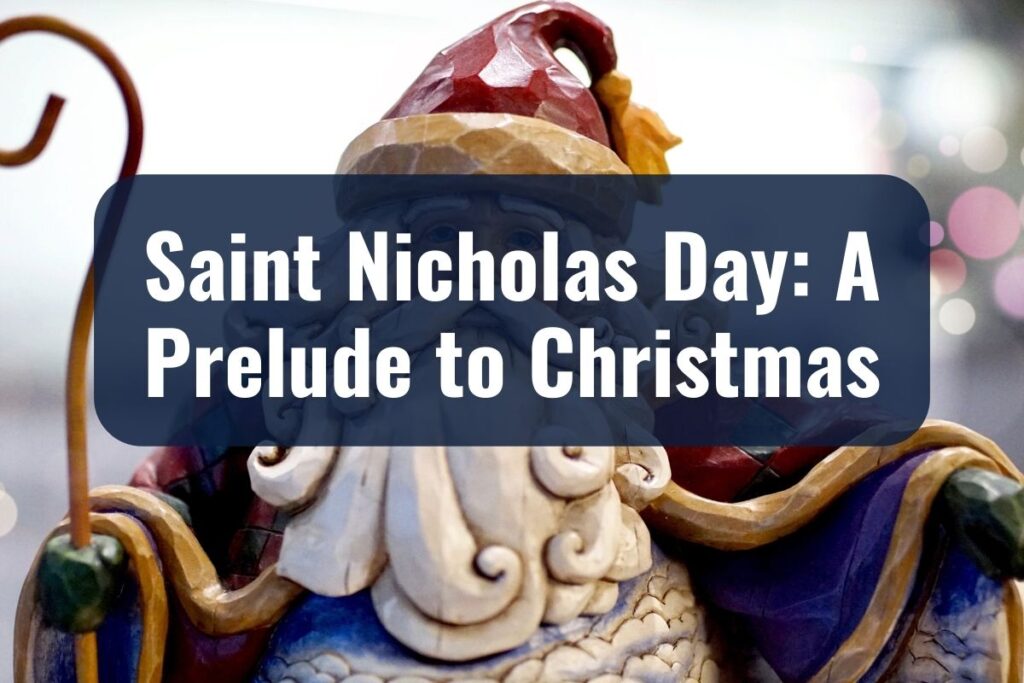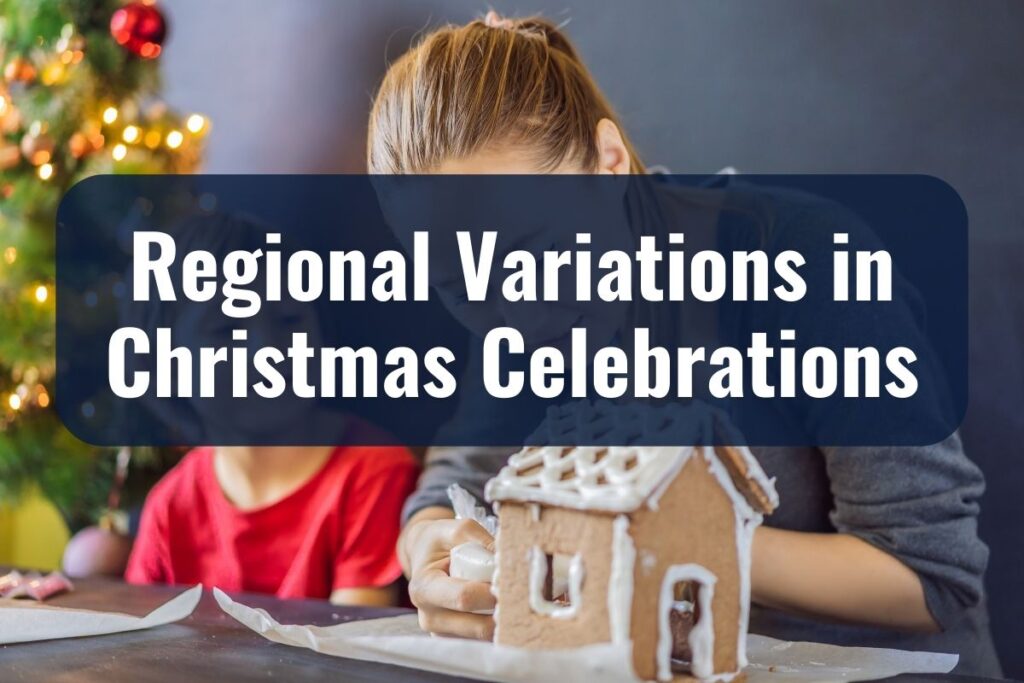Germany transforms into a winter wonderland as the Christmas season approaches. This time of the year, steeped in rich customs and vibrant celebrations, holds a special place in the heart of German culture. From the snow-kissed streets of Bavaria to the bustling markets of Berlin, each region dons a festive garb, inviting locals and visitors alike to partake in the joyous festivities.
Christmas in Germany is more than just a holiday; it’s an immersive experience that melds historical customs with contemporary celebrations. Whether you’re wandering through quaint medieval towns or exploring modern cityscapes, the essence of Weihnachten (Christmas) is palpable in every corner. For those who may not understand German, fear not, as the language of Christmas is universal here, spoken through twinkling lights, melodious carols, and the warm aroma of seasonal treats.
KEY TAKEAWAYS
- Advent in Germany is marked by traditional wreaths and calendars, symbolizing joyful anticipation.
- German Christmas markets are hubs of festive crafts, foods, and socializing.
- Traditional German Christmas includes a variety of unique sweets and hearty meals.
- Celebrated on December 6, Saint Nicholas Day is cherished for its traditions of giving and children’s joy.
- German Christmas decorations are rich in history and include unique regional styles.
- Christmas Eve and Christmas Day are the heart of the German Christmas, celebrated with family, feasting, and traditions.
- Traditional carols and music play a vital role in the German Christmas experience.
The Advent Season
As the chill of late November sets in, Germany begins its joyous march towards Christmas, marked by the start of the Advent season. This period, rich in anticipation and warmth, serves as a delightful prelude to the main festivities of Christmas.
The Advent Wreath: A Symbol of Expectation
One of the most cherished traditions is the Adventskranz or Advent wreath. This circular wreath, adorned with evergreen foliage and four candles, symbolizes the enduring hope and light in the darker winter months. Each Sunday leading up to Christmas, a new candle is lit, with family members often gathering around for a small celebration, reflecting the growing brightness as Christmas Day nears.
The Advent Calendar: Counting Down the Days
Another beloved tradition is the Advent calendar, a charming way to count down the days to Christmas. These calendars, ranging from simple paper designs to elaborate wooden creations, feature 24 doors or windows, one for each day of December leading up to Christmas Eve. Behind each door lies a small surprise, often a sweet treat or a tiny gift, adding a sense of daily excitement and wonder for both children and adults.
Preparing the Home and Heart
During Advent, German households bustle with preparations. Homes are adorned with seasonal decorations, including twinkling lights, nativity scenes, and festive ornaments. This is also a time for baking traditional Christmas cookies, known as Weihnachtsplätzchen, filling homes with the delightful aromas of cinnamon, nutmeg, and cloves.
Community and Reflection
Advent is not only a time of preparation but also one of community and reflection. Many attend special Advent church services, enjoying the serene and contemplative atmosphere. It’s a period for reconnecting with loved ones, sharing stories, and embracing the spirit of togetherness and goodwill.
The Advent season in Germany is a time when the anticipation of Christmas blends beautifully with meaningful traditions and joyful preparations. It sets the stage for the festive celebrations to come, enveloping everyone in a cozy, expectant atmosphere, truly making it the most wonderful time of the year.
Christmas Markets: A Festive Hub

As Advent unfolds, the streets and squares of German cities and towns come alive with the enchanting charm of Weihnachtsmärkte, or Christmas markets. These markets, often set against the backdrop of historic buildings and cobblestone streets, are the heartbeat of German Christmas traditions, drawing visitors into a world of festive delight.
A Journey Through Lights and Crafts
Each market, unique in its offerings, is a kaleidoscope of twinkling lights, colorful stalls, and the merry bustle of people. Artisans from near and far showcase their crafts, offering everything from hand-carved wooden toys to delicate glass ornaments. Walking through a German Christmas market is like stepping into a storybook, where each stall tells its own tale of craftsmanship and tradition.
Culinary Wonders and Warmth
The air in these markets is heavy with the scent of culinary wonders. Stalls brimming with gingerbread (Lebkuchen), marzipan sweets, and Stollen (a traditional German fruitcake) entice those with a sweet tooth. For savory cravings, there’s an array of choices like hearty Bratwurst, roasted chestnuts, and pretzels. And to ward off the winter chill, nothing beats a cup of Glühwein, the spiced mulled wine that’s synonymous with German Christmas markets.
Socializing and Celebrating
Christmas markets are not just shopping destinations; they’re social hubs. Friends gather around cozy fire pits, families meander through the twinkling aisles, and even strangers share tables and stories. The atmosphere is one of jovial camaraderie, set to the soundtrack of Christmas carols and laughter.
Famous Markets to Explore
While each market has its charm, some have gained fame for their size, beauty, or unique offerings. The Nuremberg Christkindlesmarkt is renowned for its sheer scale and historical significance. The Dresden Striezelmarkt, one of the oldest in Germany, is famous for its Stollen festival. Meanwhile, the Gendarmenmarkt in Berlin offers a more contemporary experience with its blend of traditional and modern attractions.
Culinary Delights of German Christmas
In Germany, Christmas is not only a feast for the eyes and heart but also a culinary journey that tantalizes the taste buds. German Christmas cuisine, with its rich flavors and heartwarming dishes, plays a central role in the holiday celebrations, bringing families and friends together around the dining table.
| Category | Examples | Description |
| Main Courses | Roasted Goose/Duck, Carp | Traditional meats served with sides like dumplings and red cabbage. |
| Sweet Treats | Stollen, Lebkuchen, Plätzchen | Variety of Christmas breads and cookies, each with unique flavors. |
| Beverages | Glühwein, Feuerzangenbowle | Warm, spiced drinks perfect for the festive season. |
| Regional Specialties | Marzipan (North), Wooden toys (East) | Unique culinary and craft items from different German regions. |
Traditional Christmas Foods
Christmas Goose or Duck: The centerpiece of many German Christmas dinners is a roasted goose or duck, often stuffed with apples, chestnuts, onions, and prunes, and served with red cabbage and dumplings. This hearty dish, with its crispy skin and tender meat, is a beloved tradition in many households.
Carp: In some regions, particularly in Southern Germany, carp is a traditional Christmas Eve meal. This custom, known as “Weihnachtskarpfen,” involves serving the fish either fried or steamed, accompanied by a variety of side dishes.
Sweet Treats and Baked Goods
Stollen: This iconic German Christmas bread, laden with dried fruits, nuts, and spices, and dusted with a snowy layer of powdered sugar, is a must during the festivities. Each slice of Stollen is a bite of Christmas tradition.
Lebkuchen: These spiced gingerbread cookies, often heart-shaped or round, are a staple at every Christmas market and in homes. Decorated with almonds or glazed with chocolate, Lebkuchen is both a treat and a work of art.
Plätzchen: A variety of Christmas cookies, known collectively as Plätzchen, are baked in homes throughout Germany. From buttery Spritzgebäck to jam-filled Linzer cookies, these delightful treats are often shared with neighbors and friends.
Beverages to Warm the Soul
Glühwein: No German Christmas is complete without Glühwein, the warm, spiced red wine that comforts and cheers. Often homemade, this beverage is a staple at Christmas markets and family gatherings.
Feuerzangenbowle: For a more dramatic twist, Feuerzangenbowle is a spectacular sight at parties. A rum-soaked sugarloaf is set ablaze and drips into mulled wine, creating a potent and festive drink.
Regional Specialties
Germany’s diverse regions each bring their unique flavors to the Christmas table. From marzipan in Lübeck to Christstollen in Dresden, every area has its specialties, making the culinary landscape of German Christmas both rich and varied.
Saint Nicholas Day: A Prelude to Christmas

In the heart of the festive season, on the 6th of December, Germany celebrates Saint Nicholas Day, a tradition that adds an extra layer of joy and anticipation to the Christmas period. This day, dedicated to the historic figure of Saint Nicholas, is especially beloved by children and is a charming prelude to the main Christmas festivities.
The Legend of Saint Nicholas
Saint Nicholas, known for his generosity and kindness, was a bishop who lived in the 4th century. German folklore tells of his benevolence and miracles, especially towards children and those in need. On this special day, his spirit is celebrated, reminding everyone of the importance of giving and compassion.
Customs and Celebrations
Filling of Boots: The night before Saint Nicholas Day, children clean and polish their boots and leave them outside their door or by the window. The next morning, they wake to find the boots filled with treats like candies, nuts, oranges, and small toys, supposedly left by Saint Nicholas as a reward for their good behavior throughout the year.
Saint Nicholas Visits: In some communities, someone dressed as Saint Nicholas visits homes, schools, or public gatherings, often accompanied by Knecht Ruprecht, a companion who admonishes naughty children. This visit is both a moment of excitement and a gentle reminder for children to be kind and well-behaved.
Sweet Delights
Saint Nicholas Day also brings with it special treats and sweets:
Nikolausstiefel: These are chocolate or marzipan figures shaped like boots, filled with small treats, echoing the tradition of filling actual boots.
Lebkuchenherzen: Heart-shaped gingerbread cookies, often beautifully decorated, are a popular treat given on this day.
A Day of Joy and Reflection
While Saint Nicholas Day is particularly exciting for children, it also holds a deeper significance. It’s a day for families to come together, share stories of Saint Nicholas, and reflect on the values of generosity and kindness. It’s a time when the spirit of giving is celebrated, setting the tone for the upcoming Christmas celebrations.
Decorating the German Way
As the Christmas season unfolds, Germany transforms into a wonderland of lights, colors, and festive decorations, each element echoing centuries-old traditions. German Christmas decorations are not just about adornment; they are a celebration of history, family, and the joy of the season.
The Christmas Tree: A Centerpiece of Celebration
The Christmas tree, or Tannenbaum, is perhaps the most iconic symbol of German Christmas. Traditionally, the tree is put up and decorated on Christmas Eve, a family activity filled with anticipation and joy. The Tannenbaum is adorned with lights, ornaments, and sometimes real candles, casting a warm, inviting glow.
German Christmas trees are often decorated with handcrafted ornaments, a tribute to the country’s rich craft heritage. These include wooden figurines from the Erzgebirge region, hand-blown glass baubles from Thuringia, and intricately woven straw stars.
The Nativity Scene: A Story in Figurines
Many German homes display a Weihnachtskrippe, a nativity scene depicting the birth of Jesus. These scenes range from simple wooden figures to elaborate setups with detailed landscapes, bringing the story of Christmas to life.
Advent Wreaths and Calendars
In addition to the Advent wreath with its candles, Advent calendars remain a prominent part of the decorations, counting down the days to Christmas and building excitement.
Outdoor Illuminations
German towns and cities are known for their beautiful outdoor Christmas lights and decorations. Streets, squares, and buildings shimmer with festive lights, while balconies and windows often feature stars, wreaths, and lighted silhouettes.
Unique Regional Decorations
Different regions in Germany have their unique decorative styles and traditions. From the intricate woodwork of Bavaria to the maritime-themed decorations in coastal areas, each region adds its own touch to the festive season.
Christmas Eve and Day: Family and Festivities

In Germany, Christmas Eve (Heiligabend) and Christmas Day (Weihnachtstag) are the culmination of the festive season, a time when the warmth of family and the joy of celebration come together in a splendid tapestry of tradition and happiness.
Christmas Eve: A Night of Magic
Christmas Eve holds a special place in German hearts. It’s traditionally when families gather to exchange gifts (Bescherung). The day often begins with final preparations and decorating, leading to an evening of togetherness. In many households, a special bell rings, signaling to the children that it’s time to see the decorated Christmas tree and receive presents from the Christkind or Weihnachtsmann (Santa Claus).
The Christmas Eve dinner is an important part of the celebration. While some families opt for a lavish meal, others prefer a simpler fare like sausages and potato salad, saving the more elaborate dishes for Christmas Day.
Christmas Day: A Time for Feast and Family
On Christmas Day, families often come together for a grand meal. This is the time for the traditional roast, be it goose, duck, or carp, accompanied by a variety of side dishes like dumplings, red cabbage, and rich gravies.
For many, attending a Christmas mass or service is an integral part of the day. These services, filled with carols and messages of hope and peace, add a spiritual dimension to the celebrations.
The essence of Christmas in Germany lies in the time spent with family. It’s a period of laughter, storytelling, and shared memories, strengthening the bonds that tie loved ones together.
Post-meal, families often engage in games, watch classic Christmas movies, or simply enjoy each other’s company, basking in the festive spirit.
The Second Christmas Day
In Germany, the day after Christmas, known as Zweiter Weihnachtstag or Boxing Day, is also a public holiday. This day is typically more relaxed, often spent visiting extended family and friends or enjoying outdoor activities in the winter landscape.
Music and Carols: The Sounds of German Christmas
In Germany, the festive season resonates with the rich sounds of music and carols, an integral part of the Christmas celebrations. These melodies, steeped in tradition and history, fill the air with joy and festivity, echoing the heart and soul of German Christmas.
The Tradition of Christmas Carols
Germany has given the world some of its most beloved Christmas carols. Songs like “Stille Nacht” (Silent Night), “O Tannenbaum” (Oh Christmas Tree), and “Leise rieselt der Schnee” (Softly Falls the Snow) originated in the heart of Germany, capturing the essence of the season through their poignant melodies and lyrics.
Carol singing is a common tradition, whether in churches, homes, or even outdoors. Families often gather around the piano or guitar, sharing in the joy of music. In some communities, groups of carolers walk from house to house, spreading cheer with their songs.
Church Services and Choirs
Music plays a central role in Christmas church services and midnight masses. Choirs perform classical and contemporary Christmas pieces, creating a serene and reflective atmosphere. The sound of church bells ringing out across towns and cities adds to the sacred and festive mood.
Special performances by children’s choirs are a heartwarming highlight of the season. These young voices bring a special purity and joy to the carols, reminding everyone of the innocence and wonder of Christmas.
Outdoor Concerts and Performances
Christmas markets often feature live music, with bands and solo artists performing traditional and modern carols. These performances add to the lively and communal atmosphere of the markets.
Many cities host special Christmas concerts in public squares, churches, or concert halls, showcasing professional musicians and local talent. These events are a delightful way to experience the rich musical heritage of Germany during the festive season.
The Universal Language of Christmas Music
Music at Christmas time in Germany goes beyond entertainment; it is a means of bringing people together, transcending language and cultural barriers. It’s a universal language that speaks of peace, joy, and the spirit of the season.
Regional Variations in Christmas Celebrations

Germany’s Christmas celebrations, rich and diverse, vary significantly from region to region. This variety reflects the country’s multifaceted cultural heritage, with each area adding its unique flavor to the festive season. Exploring these regional differences offers a glimpse into the tapestry of customs that make a German Christmas truly special.
Bavaria: A Snowy Alpine Christmas
Bavarian Traditions: In the snow-clad Alps of Bavaria, Christmas is a picturesque affair. Here, the Christkindlmarkt in Munich is a central attraction, while smaller villages host their own charming markets. Traditional Bavarian brass music and the famous Krampuslauf, where costumed figures accompany Saint Nicholas, add a unique touch to the festivities.
The North: Maritime Flair and Historic Charm
Celebrations in Northern Germany: In the port cities like Hamburg and Bremen, Christmas takes on a maritime flavor. The markets often feature nautical-themed decorations and specialties like marzipan, a favorite in this region. The historic architecture of these cities provides a stunning backdrop to the festive lights and markets.
Saxony: Home of the Christmas Markets
Saxon Celebrations: Saxony claims some of the oldest Christmas markets in Germany, including the famous Striezelmarkt in Dresden. This region is also the birthplace of the Christmas Stollen, a culinary highlight of the season. Handcrafted wooden decorations from the Erzgebirge mountains are a distinctive Saxon tradition.
The Rhineland: Festive Spirits and Warmth
Rhineland Festivities: In the Rhineland, Cologne and Düsseldorf host vibrant Christmas markets. The region is known for its lively celebrations, Glühwein, and Reibekuchen (potato pancakes). Unique customs like the Saint Nicholas boat processions along the Rhine add a special charm.
East Germany: A Blend of Tradition and History
East German Traditions: In the eastern part of Germany, Christmas is a blend of traditional and historical influences. Leipzig’s Christmas market is renowned, and the region has a strong tradition of wooden toy-making. Choirs singing in the St. Thomas Church, where Bach once served, is a highlight.
Southern Germany: A Rustic and Homely Christmas
Christmas in the South: The rural areas of Southern Germany offer a more rustic Christmas experience. Here, traditions are deeply rooted in the local culture, with emphasis on handcrafted decorations, local culinary specialties, and intimate, family-oriented celebrations.
Related: New to Germany: A Newcomer’s Guide to Living in Germany


